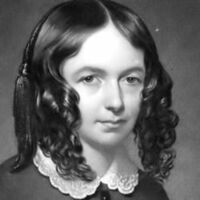The Runaway Slave at Pilgrim's Point
By Genna Rhoswen
Analysis of "The Runaway Slave at Pilgrim's Point" by Elizabeth Barrett Browning
Genna Rhoswen, Yahoo! Contributor Network
Dec 31, 2009 "Share your voice on Yahoo! websites. Start Here."
MORE:SlaveryBarrettPilgrimsElizabeth Barrett BrowningThe Runaways
tweet
Print
FlagPost a comment
I wish you who stand there five a breast,
Each, for his own wife's joy an gift,
A little corpse as safely at rest
As mine in the mangoes! Yes, but she
May keep live babies on her knee,
And sing the song she likes the best.
(lines 212-217)
The main theme or subject of the poem is a protest against slavery, but is it possible, that the poet and speaker bring up feminist issues as well? The poet uses the voice of a female and the constructs the motif of a mother-and-child relationship, which is a subject feminists are concerned about, to develop her opinions about slavery. Is it possible that the poet is not only voicing her stand against slavery, but also against the standards of domesticity on women?
In these lines she presents the double standard that women face. The white woman presents the traditional expectation that women are supposed to fulfill. They are traditionally expected to be the symbols of domesticity, in which they care for the home and the children, or in the speaker's words, "keep live babies on her knee, | And sing the song she likes the best" (line 216-217). As displayed and illustrated by the wives of the men hunting for the speaker, women are supposed to be nurturing creatures of domesticity. The speaker, however does the opposite. She does not nurture, love or care at all for her child. Even if it squirms and kicks, "moaned and struggled" (line 124), she covers the babies face and keeps the "kerchief" there (line 122). She ultimately smothers it and buries it under a mango tree, doing the complete opposite the white, traditionally domestic mothers do. She does not want to care for the child, because it is a reminder of the oppression of a black slave. The child's fair face is a reflection, a replica of the faces that oppress her. In the same way her slave owners and masters force her to work, they force her to bear a child that she does not want. Just as the white society is forcing her to be something that she is naturally not, a slave, they are forcing her to be a mother.
Being women, the poet and the speaker can have similar outlooks and the same perspective: that of a woman. If the speaker feels forced to be a mother against her will, the poet, sharing the same body, can feel the same way, but is only using the mouth of the speaker to communicate her opinions. The focus of the poem is the abolishing of slavery, but Elizabeth is bringing up subjects and issues that specifically women face: rape and motherhood. The speaker faces two double standards as woman and specifically a black woman. She is expected to be a committed slave as well as a committed mother, both she refuses. In response, she runs away from her position as a slave, by running away to Pilgrim's Point, and turns away from her responsibilities as a mother by killing her child. Elizabeth packages her opinions against slavery and domesticity in one body: a black, slave woman. Her package links together slavery and motherhood, or domesticity, together, as though to say that being forced to labor and being forced to go into labor are forms of slavery. Additionally, being a slave and being raped are two forms of violation. The first is a violation against one's independence. The other is a violation of one's body. Using the mouth and body of a black slave woman, the poet communicates her opinions about the oppressions of a slave and a woman.

